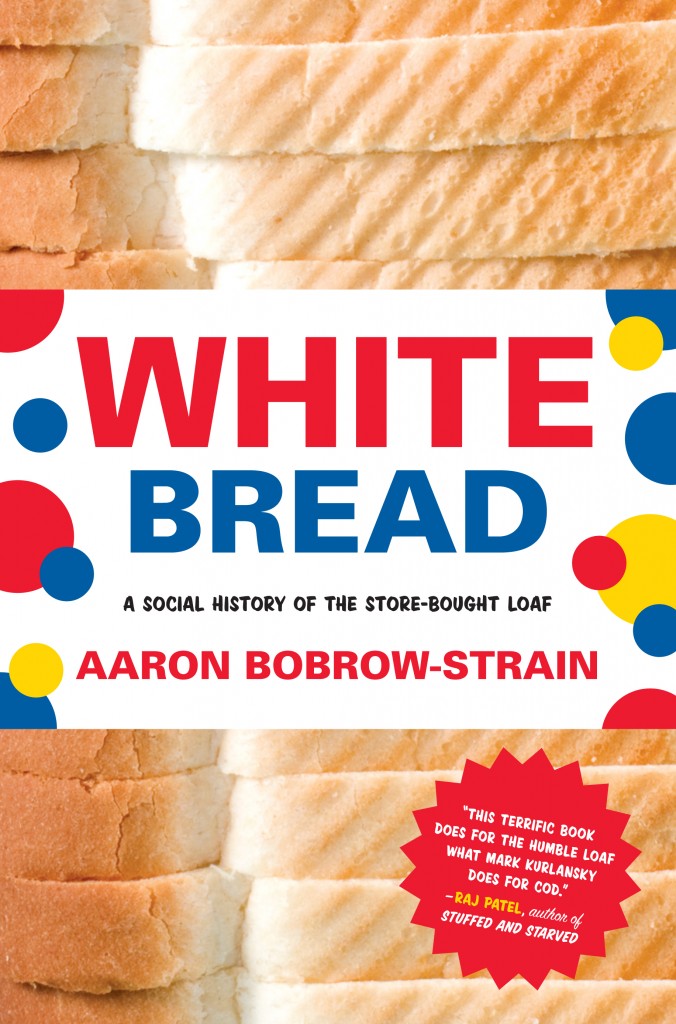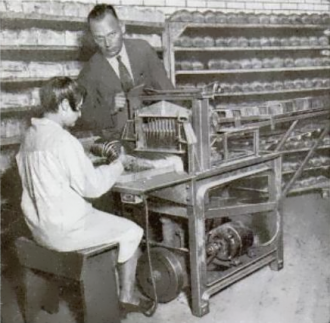 We’ve got a guest blogger on FPF this week: Aaron Bobrow-Strain the author of the new book White Bread: A Social History of the Store-Bought Loaf. Below, Aaron gives us a little teaser history of sliced bread and the reactions it garnered when it was first released.
We’ve got a guest blogger on FPF this week: Aaron Bobrow-Strain the author of the new book White Bread: A Social History of the Store-Bought Loaf. Below, Aaron gives us a little teaser history of sliced bread and the reactions it garnered when it was first released.
***
When Frank Bench, the owner of a nearly bankrupt bakery, and his friend Otto Rohwedder, an equally down-at-the-heels inventor, successfully ran the world’s first automatic bread slicer in Chillicothe, Missouri, they accomplished something nearly every member of the American baking establishment thought impossible—and utterly stupid.
By July 1928, when Bench and Rohwedder’s surprising product debuted, retail bakers had used machines to slice loaves at the point of sale for years, but few in the industry believed that bread should be automatically sliced as it came off the assembly line. Bread was too unruly. What would hold the sliced loaves together? How would slicing affect the chemistry of taste? What would prevent sliced bread from rapidly molding or staling?
Rohwedder’s designs for the automatic slicer dated back to 1917, but he found no takers for the idea and had almost given up hope. For Bench, installing the machine was a favor to his friend and a last shot in the dark. What did he have to lose?
The results astounded all observers. Sales of sliced bread soared 2000 percent within weeks, and a beaming Chillicothe Constitution-Tribune reporter described housewives’ “thrill of pleasure†upon “first see[ing] a loaf of this bread with each slice the exact counterpart of its fellows…indefinitely better than anyone could possibly slice by hand.†News spread rapidly. Sliced bread took off first in Missouri,Iowa, and Illinois, then spread throughout the Midwest by late summer 1928. By fall 1928, mechanical slicing had hit New York, New Jersey, and the West Coast. By 1930, 90 percent of all store-bought bread in the country was automatically sliced.
Some bakers dismissed sliced bread as a fad, comparing it to other Roaring Twenties crazes like barnstorming and jazz dancing. Nevertheless, as bakers wrote in frantic trade magazine articles, anyone who resisted the new technology would be crushed by the competition.

An automatic bread slicer. source: www.todayifoundout.com
While awaiting deliveries of mechanical slicers from hopelessly backordered manufacturers, bakers asked themselves a logical question: What’s so great about sliced bread? “Why does anyone want sliced bread anyway?†one baker wrote. “The housewife is saved one operation in the preparation of a meal. Yet, try as one will,the reasons do not seem valid enough to make demand for the new product.â€
He had a point. How much extra work is it really to slice your own bread? And what about housewives’ “thrill of pleasure� A little saved labor couldn’t explain a reaction like that. Why did so many people care so much about perfectly neat slices? What had sliced bread come to symbolize?
***
Aaron tracks down the answers to these questions in his new book, and the answers will surprise you.  He says “…It may get you thinking twice about our own confident visions of what counts as ‘good food.'” Ok, my interest is piqued.
But I want to throw this question out to you, readers: What do you think was/is so great about sliced bread?


Uniformity of size, “luxurious” texture, convenience, end of bread baking as a weekly chore.
Luxurious texture! Defintely.
Uniformity of size is a factor, as is portion control (you can plan and enforce how many serving you will get from each loaf).
You can also let even very young children make their own sandwiches (or bread and butter) without any real supervision, as they don’t need to use a large sharp knife.
I can’t help but think of your post about “Better Butter”. Consistency, as well as a perception of better hygiene in a factory environment, modernity, “progress”. Certainly, there was a perception that things made by machine were better, especially by virtue of uniformity, and there was an idea that they turned out a “perfect” product every time. I can’t help but think of the line to that effect from Fiddler on the Roof, just after Motle the tailor gets his sewing machine. I think that in that time, the advancement of mechanization symbolized the wave of the future, and progress. I think there was a belief in the desirability across the board of increased mechanization that is no longer held today. Uniformity had long been a sign of the skill of the craftsman, and therefor the quality and price of the good. Just think about the difference between the kind of linen that Leonardo painted on and the homespun garments that would have been available to the average person at the time, and what the price difference would have been, based on the expertise of the master spinners and weavers. Then, the transformation of the Industrial Revolution, and the ever increasing mechanization post-WWI, and here we were in 1928, in what must have felt like the beginnings of a glittering, machine-made utopic future. The prominent design style of the time was Art Deco. Frank Lloyd Wright and Charles Rennie Mackintosh were well into their carriers. The famous modernist chaise longue of le Corbusier was designed in 1928, and Charlotte Perriand designed her iconic tubular steel chairs. Ford Motor Co. was only 25 years old, and had just switched to producing the model A the year before, and the first refrigerator that was really available to the average person came on the market in 1927. It must have felt remarkable that all of this new mechanization was moving into the food world. People didn’t want bread that looked messy and left crumbs everywhere. They wanted this clean, exciting future to move into every part of their lives.
And here is that post, butter being advertised as “sanitary” http://www.fourpoundsflour.com/the-gallery-economic-sanitary-attractive-appetizing/
That post also touches on how factory made bread was promoted over home made.
Good recall, Gaidig! I had even forgotten about that post. And I think this is an excellent point that is the opposite of how we think today: good craftsmenship = uniformity. If you can handmake something that is uniform, you can fetch a high price. Then machines can make everything uniform = good craftsmenship. Today, we want flaws and irregularity in our products because it calls back to handmade products before the industrial revolution.
Really, really interesting!
I am a home breadmaker myself, so of course the loaves don’t come out presliced… thing is, I have a terrible time cutting even, thin slices, such as one would want for a sandwich. (They always come out crooked or uneven.)
I don’t use much of my bread for sandwich making, so it doesn’t matter much to me, but if you were a housewife needing to pack the whole family’s lunches I’m sure it would be an issue.
I’ve read that before sliced bread, there were detailed instructions published on how to cut bread for who and for what occasion. Like thick slices for your working man husband, thin and crust-less for afternoon tea.
“Sliced bread” just makes it easy to eat! I bake most of the bread we eat at home and at night before I go to sleep, I’ll slice it up so everyone can quickly make sandwiches in the morning. And…. so they don’t take huge chunks! This way I’ll know how soon I have to make the next loaf.
Growing up I always ate bread from my grandparent’s Brooklyn bakery and most of the time it was pre-sliced by machine, I don’t remember eating any out of a package. I actually felt I was missing something until I grew up and learned better!
It’s not great. Nearly every bakery and store cuts the bread the same thickness. The customer does not get to choose
how thick or thin they want it. That’s why I started making my own bread at home. When I want a thick piece I cut it thick and when I want it thin I can do it that way too from the same loaf.